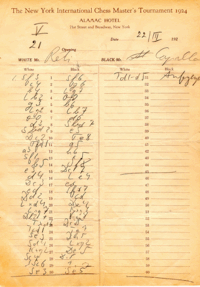
- Chess World Cup
- FIDE Grand Prix
- Olympiad
- World Championship
- List of strong tournaments
- List of world championships

- Checkmate patterns
- Chess openings
- Chess strategy
- Chess tactics
- Chess theory
- Endgames
- Pawn structure
- Problems/Compositions












|
|||||||||||||||||||||||||||||||||||||||||||||
| Moves | 1.Nf3 d5 2.c4 | ||||||||||||||||||||||||||||||||||||||||||||
|---|---|---|---|---|---|---|---|---|---|---|---|---|---|---|---|---|---|---|---|---|---|---|---|---|---|---|---|---|---|---|---|---|---|---|---|---|---|---|---|---|---|---|---|---|---|
| ECO | A04-A09 | ||||||||||||||||||||||||||||||||||||||||||||
| Origin | Réti-Rubinstein, Carlsbad, 1923 | ||||||||||||||||||||||||||||||||||||||||||||
| Named after | Richard Réti | ||||||||||||||||||||||||||||||||||||||||||||
| Parent | Flank opening | ||||||||||||||||||||||||||||||||||||||||||||
| Synonym(s) | Réti System Réti-Zukertort Opening |
||||||||||||||||||||||||||||||||||||||||||||
The Réti Opening is a hypermodern chess opening whose traditional or classic method begins with the moves:
White plans to bring the d5-pawn under attack from the flank, or entice it to advance to d4 and undermine it later. White will couple this plan with a kingside fianchetto (g3 and Bg2) to create pressure on the light squares in the center.
The opening is named after Richard Réti (1889-1929), an untitled Grandmaster from Czechoslovakia. The opening is in the spirit of the hypermodernism movement that Réti championed, with the center being dominated from the wings rather than by direct occupation.
1.Nf3 develops the knight to a good square, prepares for quick castling, and prevents Black from occupying the center by 1...e5. White maintains flexibility by not committing to a particular central pawn structure, while waiting to see what Black will do. But the Réti should not be thought of as a single opening sequence, and certainly not a single opening move, but rather as an opening complex with many variations sharing common themes.
In the Encyclopaedia of Chess Openings (ECO), Réti Opening is classified as codes A04-A09.
 Scoresheet of Réti-Capablanca, New York 1924
Scoresheet of Réti-Capablanca, New York 1924According to Réti the opening was introduced into master play in the early part of 1923. Réti used the opening most famously to defeat José Raúl Capablanca, the reigning World Chess Champion, in a game at the 1924 New York tournament. Alexander Alekhine played the Réti in the 1920s, but at that time almost any game that began with Nf3 and c4 by White was considered to be the Réti. Réti popularized these moves against all defenses in the spirit of hypermodernism, and as the opening developed it gained structure and a clearer distinction between it and other openings.
Hans Kmoch called the system of attack employed by Réti in the game Réti-Rubinstein, Carlsbad 1923, "the Réti Opening" or "the Réti System". Savielly Tartakower called the opening the "Réti-Zukertort Opening", and said of 1.Nf3: "An opening of the past, which became, towards 1923, the opening of the future."
In modern times the Réti refers only to the configuration Nf3 and c4 by White with ...d5 by Black, where White fianchettos at least one bishop and does not play an early d4.
After 2.c4 (ECO code A09), Black's choices are:
If Black takes the pawn, then in the same manner as the QGA, 3.e3 or 3.e4 regain the pawn with a slight advantage to White - Black being left somewhat undeveloped. 3.Na3 and 3.Qa4+ are also good, and commonly played. This variety of White options limits the popularity of 2...dxc4.
| a | b | c | d | e | f | g | h | ||
| 8 |

                                |
8 | |||||||
| 7 | 7 | ||||||||
| 6 | 6 | ||||||||
| 5 | 5 | ||||||||
| 4 | 4 | ||||||||
| 3 | 3 | ||||||||
| 2 | 2 | ||||||||
| 1 | 1 | ||||||||
| a | b | c | d | e | f | g | h | ||
| a | b | c | d | e | f | g | h | ||
| 8 |

                                |
8 | |||||||
| 7 | 7 | ||||||||
| 6 | 6 | ||||||||
| 5 | 5 | ||||||||
| 4 | 4 | ||||||||
| 3 | 3 | ||||||||
| 2 | 2 | ||||||||
| 1 | 1 | ||||||||
| a | b | c | d | e | f | g | h | ||
After 2.c4 e6, White can play 3.d4 for the Queen's Gambit Declined.
3.g3 Nf6 is the Neo-Catalan Opening, also under English (e.g. 1.Nf3 Nf6 2.c4 e6 3.g3 d5). Here White can play 4.d4.
After 4.Bg2, Black may play ...Be7 or ...dxc4. With move 4...Be7, White can then play 5.d4.
This goes to the Closed Catalan, avoiding Open Catalan (except classical line). Or else White can castle, then Black probably castles as well.
With 4...dxc4 to 4.Bg2, White's most common move is 5.Qa4+, and this will not correspond to a 1.d4 line.
After 2.c4 c6, White can play 3.d4 for the Slav Defense.
After 2.c4 c6 3.e3 Nf6, White can play 4.d4 for the Slav Defense.
After 2.c4 c6 3.e3 Nf6 4.Nc3 e6, White can play 5.d4 for the Semi-Slav Defense.
However, White can play 5.b3 instead.